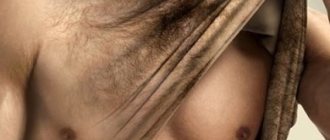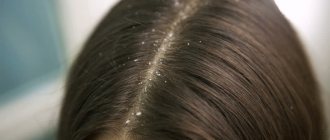Diffuse hair loss: causes and treatment
Diffuse hair loss is often called symptomatic alopecia. Daily diffuse hair loss occurs evenly in the frontoparietal, occipital, and temporal areas of the head and is normal hair loss. Normally, a follicle that has lost hair begins the hair growth stage again - anagen. The trichogram does not change, and thinning does not form. But if a significant number of hair follicles enter the resting phase ahead of time, then the anagen stage is shortened, and the percentage of telogen hair (loss) exceeds the physiological norm.
The essence of pathology
A feature of the telogen effluvium is the biological mechanism of baldness associated with a disruption in the life cycles of hair.
The main phases of hair development look like this:
- Anagen. The stage of active growth, accompanied by the division of follicle cells, as well as the production of melanin (the pigment on which hair color depends). The duration of the stage varies from 2 to 7 years.
- Catagen. A short transitional stage, lasting only a few weeks. Melanin production stops, cells stop dividing, and follicles become smaller. The hair shaft begins to move towards the epidermis.
- Telogen. The final stage lasts about three months, ending with hair loss. They are easily removed by combing, since they are already weakly held in the skin. Subsequently, new hairs are formed, which eventually replace the lost ones.
In normal condition, about 10% of the scalp is in the last phase - approximately 10,000 hairs (with an average rate of 100,000 for the entire scalp). With a 3-month duration, the process produces about 100 lost hairs per day.
Telogen effluvium is associated with disorders of the last phase. This pathology means that the overwhelming number of follicles - up to 80% - go into the telogen state, with a serious disruption of normal cycles. At the same time, hair that has not yet fallen out suffers - due to structural disorders, it becomes more brittle.
There are several stages of development for this pathology:
- acute - extremely high activity of hair loss, a significant effect appears within several weeks;
- subacute - the active process of loss takes several months;
- chronic - loss lasts for more than six months.
When does diffuse hair loss develop and how long does it last?
Severe hair loss usually develops on average after 3 months from exposure to the causative factor and can last up to 3-4 months, despite concomitant treatment. Proper hair growth begins after eliminating the trigger factor, and volume restoration occurs according to growth standards, which is about 1-1.5 cm per month. Diagnosis of hair loss is relatively complex: it is necessary to collect a detailed history, exclude possible deficient conditions, conduct a phototrichogram, and, based on the totality of the examination results, prescribe effective treatment.
What vitamins are missing?
In order for hair follicles to grow and develop normally, they require nutrients. Any serious imbalance of these elements can lead to diffuse hair loss. This is why it is so important to monitor your diet, especially if the problem is already obvious and requires a solution.
If diffuse hair loss is caused by a lack of nutrients in the body, it is most likely caused by iron deficiency. This is the second most common symptom after thinning nails. For this reason, doctors often prescribe medications that contain iron when treating diffuse baldness.
The problem can also develop against the background of a shortage of:
- sulfur;
- Selena;
- zinc;
- copper;
- potassium;
- magnesium;
- silicon
Vegetarians and vegans are at particular risk because they often do not get enough nutrients. Food of animal origin is also important for the body. Valuable substances are found in meat, dairy products, and eggs. Their deficiency is a serious factor provoking diffuse baldness.
Diffuse loss of cause
- One of the most common factors that cause hair loss is chronic stress, depression, and neurotic conditions. Hair has a rich nervous innervation, thus there is a direct relationship between the nervous system and the hair follicle. Therefore, the effectiveness of hair loss treatment in this case will depend on the successful correction of the patient’s psycho-emotional status.
Also, excessive diffuse alopecia is provoked by the following reasons:
- previous intoxication with fever (38 degrees or more), general anesthesia, taking certain medications (antibiotics, immunostimulants, oral contraceptives, etc.), sudden fasting or sudden loss of body weight, endocrine diseases not associated with hyperandrogenism, etc. Today More than 200 reasons for the development of diffuse alopecia are described today.
- Deficiency conditions: deficiency of proteins, essential microelements, vitamins, amino acids can lead to deterioration in the structure and quality of hair and aggravate hair loss.
- The seasonality factor is also a common cause of hair loss; the peaks of increased shedding occur in spring and, most importantly, in autumn.
The key to successful treatment of diffuse hair loss is
1. identification of the causative factor and its elimination, so-called specific etiotropic therapy. This is taking medications that compensate for identified deficiencies, such as iron supplements for anemia, amino acids for protein-calorie deficiency, etc.
2. active use of nonspecific treatment methods: external cosmetics and physiotherapeutic measures that have an effect regardless of the existing problem. These manipulations act as a kind of hair growth activators. By improving microcirculation, activating metabolism in the hair follicle, providing an anti-inflammatory, antiseborrheic effect, they contribute to faster and better restoration of hair damaged by diffuse hair loss. Among the physiotherapy procedures, the most popular are microcurrent therapy, laser therapy (low-intensity lasers), ultraphonophoresis and ultrasonic peeling, and ozone therapy. The absolute favorite is head mesotherapy with the introduction of individually selected drugs. The hair follicle is an intensively dividing mini-organ, characterized by a high speed of processes, hence it needs an uninterrupted supply of amino acids, vitamins, microelements and other components for adequate production of healthy hair. With the help of mesotherapy, the possibility of rapid targeted delivery of the substrate for high-quality hair follicle growth is realized. It should be remembered: during a trichological appointment, diffuse hair loss is one of the most common causes of complaints in women. An integrated, systematic approach to the diagnosis and treatment of symptoms is paramount, allowing for control of the disease, ensuring the most favorable prognosis.
| Diffuse hair loss is characterized by profuse | There is an increase in the % of telogen in both the parietal and occipital zones. There is no thinning. | Most often, thinning is more noticeable in the temple area | |
Diagnostics
Important! You should consult a doctor if you are experiencing baldness for the first time and have just begun to notice its symptoms. Don’t put off consulting a trichologist until later. The later you turn to specialists for therapy, the more complex and lengthy it will be.
Before treating the pathology, the trichologist will prescribe a comprehensive examination, including:
- Blood tests (general and biochemical tests). They allow you to assess the patient’s general health, identify inflammation, characteristics of the immune system and other important factors.
- Hormonal studies. They allow you to assess the functionality of the thyroid gland, adrenal glands and ovaries.
- Allergy tests. Thanks to them, pathologies are identified that can also cause baldness.
- Ultrasound of the genital organs and thyroid gland.
If necessary, other laboratory tests and instrumental examinations are carried out to identify the diffuse form of pathology. The condition of the hair and scalp is also diagnosed.
Low Level Laser Therapy (LLLT)
Low level laser therapy has the following effects:
- Anti-inflammatory: increased microcirculation, changes in prostaglandin levels, equalization of osmotic pressure, decreased swelling, activation of superoxide dismutase and catalase, decreased lipid peroxidation.
- Painkiller: activation of neuronal metabolism, increased levels of porphyrins, increased pain threshold.
- Reparative: accumulation of ATP, activation of cell metabolism, increased proliferation of fibroblasts and other cells, protein and collagen synthesis, neoangionenesis.
- Immunomodulatory: increased proliferation of immune cells, increased production of immunoglobulins.
The infrared radiation spectrum is more often used, 10-40 mW/cm2.
Androgenetic alopecia (stage 3 according to Ludwig or stage 4 or more according to Norwood)
sample course for 1 year
- Dermatological trichological peelings Course 5-10 times, 1 time per week (depending on scalp type) + home care
- Electropulse therapy with a professional trichological agent (mens therapy, fluctuarization) Course of 20 procedures, 2 times a week + home care
- Low-intensity laser therapy (NLT) + magnetic therapy: Local technique (scalp) or local + general technique Course of 20 procedures. 2 times a week + home care.
Then take a 1 month break and repeat the course.
Additionally:
- Dietary supplements with “plant estrogen precursors” for women (wild yam, red clover, etc.);
- Hormone replacement therapy for men and women;
- Adaptogens, metabolics, nootropic drugs, angioprotectors, antioxidants;
- Correction of metabolic syndrome;
- Avoidance of polypromasia, preference for a healthy lifestyle.
Systemic treatment is often prescribed by an endocrinologist or therapist. Local treatment is regular, in fact, permanent.
The original article was published in the journal Vestnik Trichology
Dermatological peelings
Dermatological peelings. Improved skin quality
Dermatological peelings provide a decrease in the cohesion of corneocytes in the stratum corneum, but with a further increase in concentration and inclusion of the medium, they will begin to cause a weakening of the connection of desmosomes, at very high concentrations - epidermolysis (destruction of desmosomes in the banal layer of the epidermis). The external manifestation is peeling of the skin.
In addition, peels are responsible for modulating the accelerated turnover of cellular matrix and collagen structure (via anti-inflammatory stimulation mediated by IL-1 alpha). Helps increase the content of hyalic acid in the epidermis and dermis, as well as enhance the synthesis of ceramides in keratinocytes.
Dermatological peelings. Protection and treatment
Dermatological peels improve the reactivity of the skin barrier and increase the skin's resistance to irritation caused by sulfactants.
They also inhibit the development of UVR-induced damage, including tumors (blocking the UVR-induced apostle, inhibition of the p52-p21 pathways, reducing the expression of UVR-induced regular cell cycle proteins, signaling mediators p38 kinase, mitogen-activated protein kinase.
Promotes increased penetration of related substances and also has an irritating effect, which is useful for alopecia.
Therapeutic methods
Therapeutic methods should be:
- pathogenetically substantiated (anti-inflammatory, trophic, defibrosing effect);
- with known effectiveness (combined high-evidence and low-evidence);
- well tolerated;
- compatible with each other;
- the therapeutic course must be of sufficient duration.










